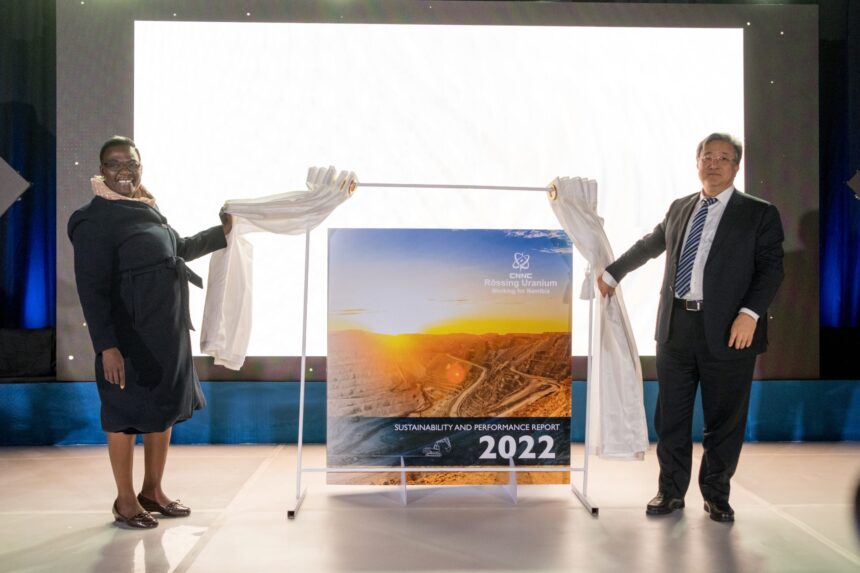Having spent slightly above N$3 billion on goods and services for operations in 2021, Rossing Uranium increased this spree in 2022, this time spending N$3.4 billion and cementing its place as not just a major employer in Namibia but also a significant economic contributor to the Erongo region and to Namibia as a whole.
As with previous reporting years, most of the procurement expenditure was on Namibian-registered suppliers, the company affirmed in its recently released Sustainability and Performance Report.
In essence, Rössing’s spend on local suppliers amounted to N$2.54 billion during 2022 (2021: N$2.25 billion), accounting for 74 per cent of our total procurement expenditure.
“The continued high percentage local spend reflects the company’s confidence to procure locally,” the uranium miner said.
N$386 million was spent on South African suppliers, representing 11 percent of procurement expenditure, while N$501 million was spent on international suppliers, representing 15 percent of total expenditure.
Notably, Rössing remains committed to supporting local suppliers, including spending on developing SMEs. The bulk of the Namibian spend remains in the Erongo (35 percent) and Khomas (52 percent) regions. Spend in other regions of Namibia amounted to 13 percent, with the highest spend in the northern region due to the current Supply of Sulphuric Acid agreement with Dundee Precious Metals in Tsumeb.
“We remain committed to supporting government development initiatives and the New Equitable Economic Empowerment Framework (NEEEF) through preferential procurement. As such, we support local suppliers and continue to enhance our data regarding supplier ownership and employment statistics, which we also report on a quarterly basis to the Namibia Competition Commission.
“Of our Namibian spend, 60% (2021: 62%) came from suppliers that confirmed majority Namibian ownership, while 88% (2021: 90%) of the total Namibian spend came from suppliers that employ 75% or more Namibians in their workforce.
In the below-N$250,000 spend category, N$518 million (2021: N$474 million) was generated in Namibia, of which 68% came from suppliers with majority Namibian ownership, while 83% was from suppliers that employ 75% or more Namibians in their workforce,” said the miner.
During the reporting period, Rossing also purchased N$110 million (2021: N$86 million) worth of goods and services from previously disadvantaged Namibians and local small and medium-sized enterprises.
In the same financial year, the miner’s revenue was higher than 2021 by 14%, despite sales volumes being 14% lower than prior year.
“The lower sales volumes resulted from lower production in the current year, significantly impacted by the prolonged unplanned desalination water outage during December, despite being partially mitigated by the additional Rössing water reservoirs capacity. However, the macro-economic parameters assisted to achieve an exceptional financial performance.
“While a weaker local currency, high inflation and commodity price spikes had a significant negative impact on costs, the uranium price also increased and the combination of being able to capitalise on the higher spot price, combined with a strong US dollar, resulted in a strong revenue stream, ultimately mitigating the negative cost challenges. This enabled the company to achieve an increased net profit after tax from normal operations of N$840 million (2021: N$193 million), which also resulted in the company declaring a total interim dividend of N$49.7 million (2021: NIL),” added Rossing.
Managing Director, Johan Coetzee also stated that a highlight for Rossing in 2022 was the commissioning of the mine’s new water reservoirs at a cost of N$100 million.
“These reservoirs provide an additional 60,000 cubic meters of storage capacity, enabling us to continue operating during periods of high sulphur bloom in the Atlantic ocean, resulting in fresh water supply interruptions due to the stoppage of the Orano desalination plant during these periods,” he said.
Rossing’s production in 2022 was lower when compared to 2021. A total of 16.6 million tonnes was mined, compared to 20.7 million tonnes in 2021, with waste and low-grade ore totalling 7.4 million tonnes. The lower mining volume was due to the stripping ratio of waste to ore reducing as we move deeper into the pit. 9.0 million tonnes of ore was milled, compared to: 9.6 million tonnes milled in 2021.
A total of 2 659 metric tonnes uranium oxide was produced, compared to 2,882 metric tonnes in 2021.
Rossing contributed approximately 4.4% to world primary production during 2022, with Namibia now being the 3rd largest primary producer of U308 globally, after Kazakhstan, (who continues to dominate the market from a supply side), and Canada.
“During 2022, Rossing has been operating on an approved LoM plan to 2026, but has now completed a bankable feasibility study for a Life of Mine extension to 2036. This can be achieved with a further pushback of the existing SJ Pit (Phase 4), fully utilising the 15-year mining licence granted by the Ministry of Mines and Energy in 2021. The objective of the LoME Feasibility Study was to evaluate and document the technical, practical, and economic feasibility to extend the LoM beyond 2026 and issue a Feasibility Study Report to inform an investment decision by the Rossing Board of Directors,” added Coetzee.



Leave a Reply